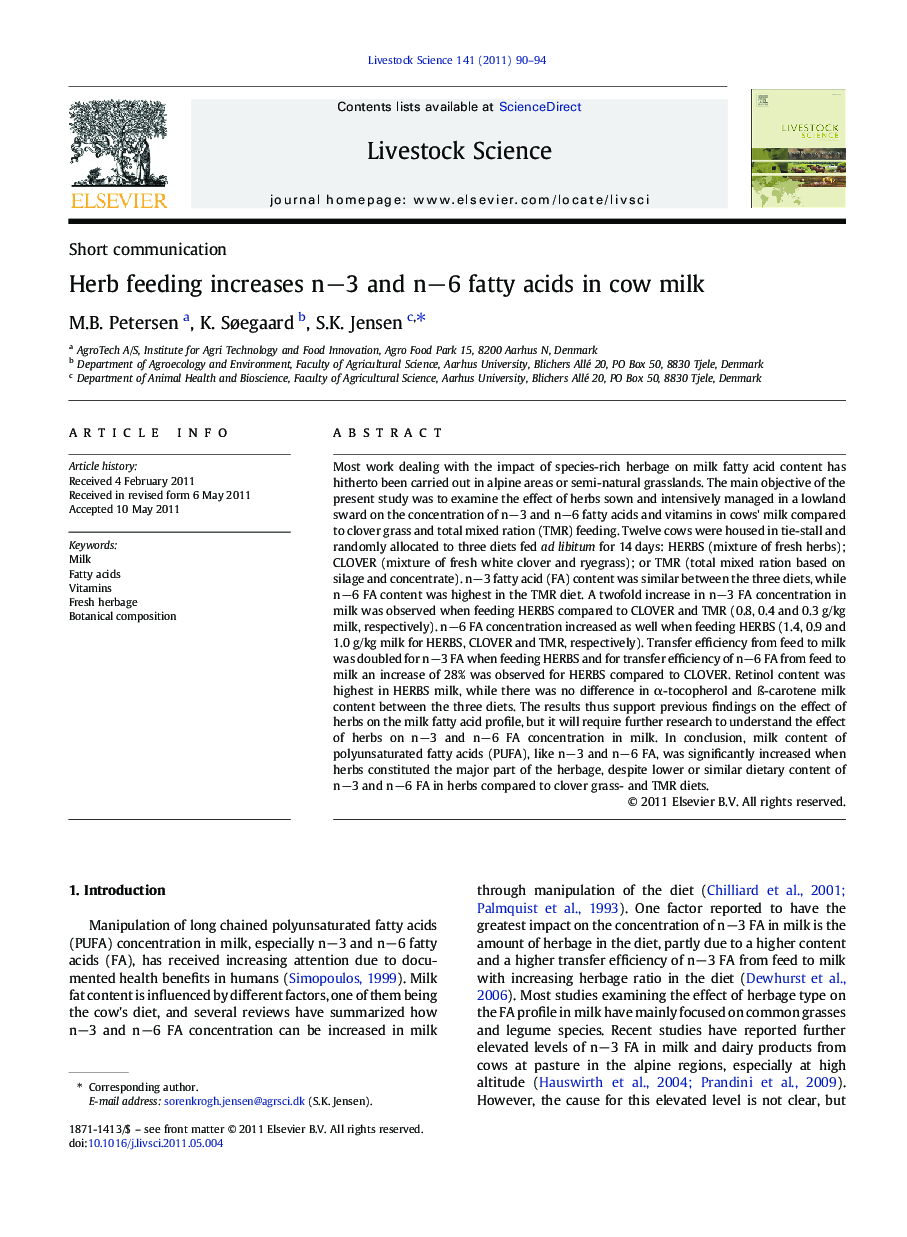| کد مقاله | کد نشریه | سال انتشار | مقاله انگلیسی | نسخه تمام متن |
|---|---|---|---|---|
| 5790851 | 1109511 | 2011 | 5 صفحه PDF | دانلود رایگان |
عنوان انگلیسی مقاله ISI
Herb feeding increases nâ3 and nâ6 fatty acids in cow milk
دانلود مقاله + سفارش ترجمه
دانلود مقاله ISI انگلیسی
رایگان برای ایرانیان
کلمات کلیدی
موضوعات مرتبط
علوم زیستی و بیوفناوری
علوم کشاورزی و بیولوژیک
علوم دامی و جانورشناسی
پیش نمایش صفحه اول مقاله

چکیده انگلیسی
Most work dealing with the impact of species-rich herbage on milk fatty acid content has hitherto been carried out in alpine areas or semi-natural grasslands. The main objective of the present study was to examine the effect of herbs sown and intensively managed in a lowland sward on the concentration of nâ3 and nâ6 fatty acids and vitamins in cows' milk compared to clover grass and total mixed ration (TMR) feeding. Twelve cows were housed in tie-stall and randomly allocated to three diets fed ad libitum for 14 days: HERBS (mixture of fresh herbs); CLOVER (mixture of fresh white clover and ryegrass); or TMR (total mixed ration based on silage and concentrate). nâ3 fatty acid (FA) content was similar between the three diets, while nâ6 FA content was highest in the TMR diet. A twofold increase in nâ3 FA concentration in milk was observed when feeding HERBS compared to CLOVER and TMR (0.8, 0.4 and 0.3 g/kg milk, respectively). nâ6 FA concentration increased as well when feeding HERBS (1.4, 0.9 and 1.0 g/kg milk for HERBS, CLOVER and TMR, respectively). Transfer efficiency from feed to milk was doubled for nâ3 FA when feeding HERBS and for transfer efficiency of nâ6 FA from feed to milk an increase of 28% was observed for HERBS compared to CLOVER. Retinol content was highest in HERBS milk, while there was no difference in α-tocopherol and Ã-carotene milk content between the three diets. The results thus support previous findings on the effect of herbs on the milk fatty acid profile, but it will require further research to understand the effect of herbs on nâ3 and nâ6 FA concentration in milk. In conclusion, milk content of polyunsaturated fatty acids (PUFA), like nâ3 and nâ6 FA, was significantly increased when herbs constituted the major part of the herbage, despite lower or similar dietary content of nâ3 and nâ6 FA in herbs compared to clover grass- and TMR diets.
ناشر
Database: Elsevier - ScienceDirect (ساینس دایرکت)
Journal: Livestock Science - Volume 141, Issue 1, October 2011, Pages 90-94
Journal: Livestock Science - Volume 141, Issue 1, October 2011, Pages 90-94
نویسندگان
M.B. Petersen, K. Søegaard, S.K. Jensen,